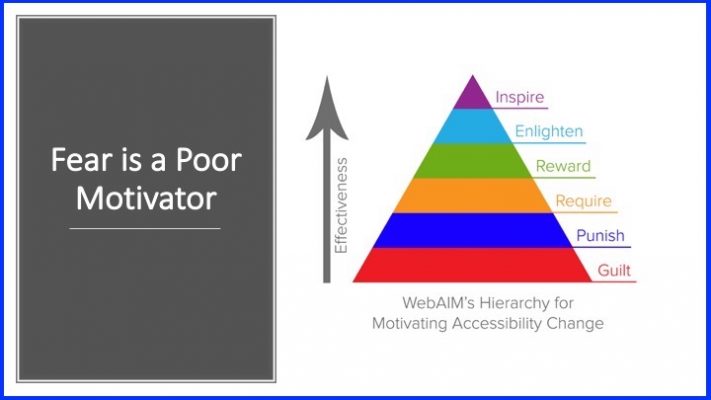
For a recent keynote delivered at the third annual ICT Accessibility Testing Symposium I included the slide pictured with this post. If social media is any indication, it was far and away the most popular slide in my talk.
The slide image was developed by Jared Smith of the accessibility consultancy WebAIM and is titled “WebAIM’s Hierarchy for Motivating Accessibility Change.” It consists of an upward-pointing triangle with colored stripes and text associated with each stripe. Bottom to top the colored bands read “guilt, punish, require, reward, enlighten, inspire.” The arrow labeled “Effectiveness” on the left points upward, indicating that guilt is the least effective motivator, inspire is the most.
I remembered the image, first introduced in a 2013 WebAIM blog post written by Jared, and knew it was a perfect fit for the message I was delivering in my talk. Jared used the terms “guilt” and “punishment,” while I’ve been using the word “fear” to describe poor accessibility drivers. Long before the onslaught of accessibility lawsuits driving (yet too often limiting) digital accessibility efforts for so many in 2018, Jared wrote:
“Be accessible or you’ll get sued” and “If your site is not fully accessible, we’ll boycott your company” are common methods of using punishment to motivate accessibility. The results are that people inevitably do the minimum amount possible to avoid punishment rather than building truly accessible products.
Guilt and punishment are the most dangerous motivators because they can easily cause people with disabilities to be viewed as enemies and antagonists, rather than beneficiaries of and potential contributors to accessibility.
Jared Smith, WebAIM’s Hierarchy for Motivating Accessibility Change (2013)
Digital accessibility is a civil right of disabled people. Without it, people with disabilities are denied participation and excluded. Privacy is compromised and security is threatened when people with disabilities cannot independently use technology and are forced to ask for assistance.
The threat to privacy flowing from the lack of access is the basis of a recent lawsuit filed by blind Walmart shoppers who needed assistance to use the store’s self-check kiosks. The store employee supposedly helping them instead stole from them; they should have been able to check out independently.
Many digital accessibility lawsuits — like the Walmart kiosk case — are civil rights cases; brought to ensure inclusion and protect independence. Brought when people with disabilities experience barriers to full and equal participation.
News articles about the Walmart case state that plaintiffs, including the National Federation of the Blind, notified the company and attempted to work collaboratively to remove access barriers. Such advance notice is not (and should not) be required, but it is a sign that the lawsuit’s goal is true accessibility.
Far too many other lawsuits, however, are primarily lawyer-driven, using what appear to be form complaints reflecting little or no research into a company’s accessibility policies and practices, and settling quickly behind a veil of confidentiality. The sheer number of these suits — brought by just a handful of lawyers — are creating an environment of fear that risks minimal compliance, backlash, and lack of follow-through.
This type of fear, as Jared Smith predicted more than five years ago in his blog post, causes “people with disabilities to be viewed as enemies and antagonists.” It taints plaintiffs in disability rights lawsuits who have experienced barriers to inclusion and are exercising rights under federal and state law.
And it taints their lawyers. Lawyers in private practice (like me) or those working for non-profits and government agencies, using the tools of litigation that have protected civil rights of various groups of people — including women, racial and ethnic minorities, members of the LGBTQ community, immigrants, disabled people and more — for decades.
Fear also casts its long yet constricting shadow on claimants seeking to enforce their rights with other strategies, including Structured Negotiation.
Accessibility is not a one and done issue. It is not something that goes away when a lawsuit is over. Fear places too much emphasis on compliance, leading organizations to lose sight of what accessibility is really about — the ability of disabled people to use today’s technology, to have access to today’s information.
It also leads organizations to minimize — or even forget entirely — the rewards of accessibility, a much higher motivator according to the WebAIM Hierarchy. Some of those rewards are explored in the newly updated document from the Web Accessibility Initiative — The Business Case for Digital Accessibility.
Fear leads to questions like the one I wrote about this summer: “If the captions on online videos are 65% accurate do you think that would comply with legal responsibilities?”
True accessibility must be baked into an organization’s culture, something I’ve spoken of frequently, using cookies as a metaphor.
Fear, punishment, and guilt have never baked a yummy cookie. I’m confident they can’t lead to a robust and mature accessibility program either.
Big thanks to Kelsey Hall, the Assistive Technology Center Coordinator at University of Massachusetts, Amherst, for sharing my slide with the WebAIM Motivational Hierarchy on social media, where it sparked great conversation and interest around problems with fear as an accessibility motivator.